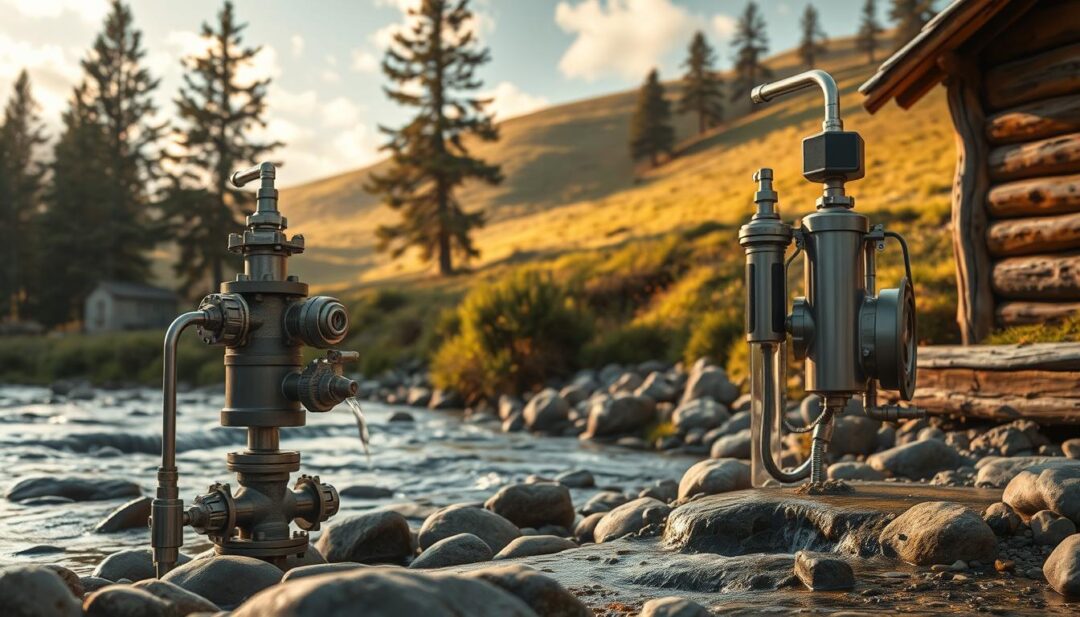Hydraulic Ram Pumps: Efficient Water Lifting Without Electricity
For over two centuries, hydraulic ram pumps have been used to lift water in areas lacking reliable power sources, showcasing a remarkable alternative to traditional pumping systems.
This ingenious technology harnesses the kinetic energy of flowing water to lift a portion of it to a greater height, eliminating the need for external energy sources. As a sustainable water solution, hydraulic ram pumps offer an efficient and reliable means of water management.
Key Takeaways
- Efficient water lifting without electricity
- Utilizes kinetic energy of flowing water
- Sustainable solution for water management
- Ideal for areas with limited power sources
- Reliable and low-maintenance technology
- Over two centuries of proven usage
The Power of Hydraulic Ram Pumps
The significance of hydraulic ram pumps lies in their ability to lift water without electricity. These devices harness the energy of flowing water to pump a portion of that water to a higher elevation, making them a vital component in sustainable water management.
What Are Hydraulic Ram Pumps?
Hydraulic ram pumps are simple, low-cost devices that utilize water pressure to pump water uphill. They operate by using the kinetic energy of flowing water, which makes them an eco-friendly water pump solution. This technology is particularly beneficial in remote areas where access to electricity is limited.
A Brief Overview of Their Significance
Hydraulic ram pumps play a crucial role in providing a sustainable and efficient solution for water supply. They are a form of renewable water technology that reduces reliance on electric pumps, thereby lowering operational costs and environmental impact.
| Benefits | Description |
|---|---|
| Eco-friendly | Uses kinetic energy of flowing water |
| Low Operational Cost | No electricity required |
| Sustainable | Reduces reliance on electric pumps |
As noted by experts, “Hydraulic ram pumps are an innovative solution for water supply challenges, especially in off-grid locations.” This highlights their potential in addressing water management issues sustainably.
Historical Development of Hydraulic Ram Pumps
Joseph Michel Montgolfier’s invention of the hydraulic ram pump in the late 18th century marked the beginning of a new era in non-electric water pumping. This innovation was crucial for communities seeking to establish reliable off-grid water systems without the need for electricity.
Early Innovations and Inventors
The hydraulic ram pump was first invented by Joseph Michel Montgolfier in 1796. Montgolfier, known for his work on hot air balloons, applied the principle of the water hammer effect to create a pump that could lift water without the need for external power sources.
Evolution Through the Centuries
Over the centuries, the design of hydraulic ram pumps has evolved significantly. Improvements in materials and manufacturing have made these pumps more efficient and durable. Today, they are used in various applications, from domestic water supply to agricultural irrigation.
| Century | Development |
|---|---|
| 18th | Invention by Joseph Michel Montgolfier |
| 19th | Improvements in design and materials |
| 20th | Modern manufacturing techniques and wider adoption |
Modern Adaptations and Improvements
Modern hydraulic ram pumps are designed to be more efficient and require less maintenance. Advances in technology have led to the development of pumps that can operate effectively in a variety of conditions, making them ideal for non-electric water pumping needs.
Understanding the Physics Behind Ram Pumps
Understanding the physics behind ram pumps requires delving into the intricacies of the water hammer effect and its role in renewable water technology. Hydraulic ram pumps are a testament to innovative engineering, utilizing the power of flowing water to create a reliable water lifeline.
The Water Hammer Effect
The water hammer effect is a critical component of the hydraulic ram pump’s operation. It occurs when the waste valve suddenly closes, creating a pressure surge that drives the pump. This phenomenon is harnessed to lift water to higher elevations, making it a crucial aspect of the pump’s functionality.
Energy Conversion Principles
The energy conversion principles in a hydraulic ram pump involve harnessing the kinetic energy of flowing water and converting it into potential energy. This process enables the pump to lift water to a higher elevation, providing a sustainable solution for water supply needs.
Hydraulic Cycle Explained
The hydraulic cycle in a ram pump is a continuous process that involves the intake of water, the creation of pressure through the water hammer effect, and the delivery of water to a higher elevation. Understanding this cycle is essential to appreciating the efficiency and reliability of hydraulic water pumps.
| Component | Function | Importance |
|---|---|---|
| Drive Pipe | Channels water to the pump | Essential for operation |
| Waste Valve | Creates pressure surge | Critical for efficiency |
| Air Chamber | Regulates pressure | Vital for smooth operation |
Essential Components of a Hydraulic Ram Pump
The functionality of a hydraulic ram pump is deeply rooted in its components. A hydraulic ram pump operates efficiently due to its well-designed parts, which work together to lift water without the need for electricity.
Drive Pipe and Delivery Pipe
The drive pipe and delivery pipe are critical components that convey water from the source to the pump and then to the delivery point. The drive pipe is typically larger and is responsible for supplying water to the pump, while the delivery pipe carries the pressurized water to its final destination.
Waste and Delivery Valves
The waste valve and delivery valve are crucial for controlling the flow of water. The waste valve allows excess water to escape, creating the water hammer effect that drives the pump, while the delivery valve ensures that water flows in one direction towards the delivery point.
Function and Importance
The proper functioning of these valves is essential for the efficiency of the hydraulic ram pump. The valves must be durable and resistant to corrosion to ensure a long lifespan.
Material Considerations
Materials used for the valves and pipes should be chosen based on durability and resistance to corrosion. Common materials include stainless steel, brass, and certain plastics that can withstand the water pressure and flow.
Air Chamber and Pressure Vessel
The air chamber and pressure vessel play a vital role in regulating the pressure and flow rate of the water. The air chamber helps to cushion the shock of the water hammer effect, while the pressure vessel stores energy that is used to push water through the delivery pipe.
As Joseph Montgomerie once said, “The hydraulic ram is a most ingenious device for raising water.” This ingenuity is reflected in the careful design and selection of its components.
Hydraulic Ram Pumps: The Zero-Electricity Water Lifesaver
For communities off the grid, hydraulic ram pumps provide a lifeline for accessing clean water. These pumps are designed to lift water from a source, such as a river or pond, to a location where it’s needed, all without the use of electricity.
Energy Independence Benefits
One of the primary advantages of hydraulic ram pumps is their ability to operate independently of electric power. This makes them ideal for remote locations where access to electricity is limited or unreliable. By harnessing the energy of flowing water, these pumps can provide a consistent and reliable water supply.
Resilience During Power Outages
In areas prone to power outages, hydraulic ram pumps offer a resilient solution for water supply. Unlike traditional electric pumps, they continue to function even during extended power outages, ensuring that communities remain supplied with water.
Sustainable Water Access in Remote Locations
Hydraulic ram pumps are particularly beneficial in remote or off-grid locations. They provide a sustainable solution for accessing water, reducing reliance on external energy sources and minimizing environmental impact.
| Benefits | Description |
|---|---|
| Energy Independence | Operates without electricity, ideal for remote areas. |
| Resilience | Continues to function during power outages. |
| Sustainability | Reduces reliance on external energy sources. |
Practical Applications for Homes and Farms
With their ability to lift water without electricity, hydraulic ram pumps have numerous practical uses for homes and farms, providing a sustainable water solution that is both efficient and reliable.
Domestic Water Supply Systems
Hydraulic ram pumps can be used to supply water to homes, especially in areas where electricity is not readily available. They provide a reliable and eco-friendly water pump solution for domestic needs.
Agricultural Irrigation Solutions
For agricultural purposes, hydraulic ram pumps offer an efficient way to irrigate crops without the need for electricity. This makes them an ideal renewable water technology for farms.
Livestock Watering Systems
Livestock can be watered using hydraulic ram pumps, ensuring that animals have access to clean water at all times. This is particularly beneficial for farms in remote locations.
Pond and Water Feature Circulation
Hydraulic ram pumps can also be used to circulate water in ponds and other water features, maintaining water quality and preventing stagnation. This contributes to a hydraulic water pump system that is both effective and sustainable.

In summary, hydraulic ram pumps offer a range of practical applications for homes and farms, providing a reliable and sustainable water solution.
DIY Hydraulic Ram Pump Projects
Hydraulic ram pumps offer an efficient way to lift water without electricity, and building one yourself can be a rewarding project. This method of water pumping is particularly useful for off-grid locations or areas with limited access to electricity.
Materials and Tools Needed
To start your DIY hydraulic ram pump project, you’ll need several key materials and tools. These include a drive pipe, delivery pipe, waste valve, delivery valve, and an air chamber. The specific materials can vary based on the design and size of the pump you wish to build.
- Drive pipe and delivery pipe
- Waste and delivery valves
- Air chamber or pressure vessel
- Teflon tape or pipe sealant
- Wrenches and pipe cutters
Step-by-Step Building Instructions
Building your hydraulic ram pump involves several steps, starting with assembling the valves and pipes according to your design. Ensure all connections are secure and sealed properly to prevent leaks.
- Assemble the drive pipe and attach it to the waste valve.
- Connect the delivery valve to the air chamber.
- Secure all connections with wrenches and apply sealant as needed.
Testing and Optimization Tips
After assembling your DIY hydraulic ram pump, it’s crucial to test it and optimize its performance. This involves checking for leaks, adjusting the valves, and ensuring the pump is operating at its maximum efficiency.
Measuring Efficiency
To measure the efficiency of your hydraulic ram pump, monitor the flow rate and pressure. Compare these metrics against the theoretical maximum to determine how well your pump is performing.
Troubleshooting Common DIY Issues
Common issues with DIY hydraulic ram pumps include air leaks, improper valve adjustment, and clogged pipes. Regular maintenance and inspection can help identify and resolve these issues promptly.
Commercial Hydraulic Ram Pumps Available in the US
In the realm of renewable water technology, commercial hydraulic ram pumps are making significant strides in the US. These pumps offer an eco-friendly and cost-effective solution for water lifting needs, particularly in rural or off-grid areas.
Top Manufacturers and Models
Several manufacturers in the US specialize in producing high-quality hydraulic ram pumps. Some of the top models include:
- PumpWorks: Known for their durable and efficient pumps, suitable for agricultural and domestic use.
- Rife Hydraulic Ram Pumps: Offers a range of models with varying capacities, ideal for different applications.
- Parker Pumps: Provides high-performance hydraulic ram pumps designed for heavy-duty use.
Price Ranges and Specifications
The price of commercial hydraulic ram pumps varies widely based on the model, capacity, and manufacturer. Here’s a comparison table to illustrate the price ranges and key specifications:
| Manufacturer | Model | Capacity (liters/hour) | Price (USD) |
|---|---|---|---|
| PumpWorks | PW-100 | 1,000 | 800 |
| Rife | RHRP-50 | 500 | 600 |
| Parker | PHRP-200 | 2,000 | 1,200 |
Customer Reviews and Performance Comparisons
Customer reviews indicate that these pumps are reliable and efficient, with some users reporting significant savings on energy costs. Performance comparisons show that the choice of pump depends on specific application needs, including the volume of water to be lifted and the available water source.
When selecting a commercial hydraulic ram pump, it’s essential to consider factors such as durability, maintenance requirements, and compatibility with your existing water system. By choosing the right pump, users can enjoy a sustainable and cost-effective water pumping solution.
Installation Guide for Hydraulic Ram Pumps
A well-planned installation is crucial for the optimal performance of a hydraulic ram pump. This guide will walk you through the essential steps to ensure a successful setup.
Site Selection and Assessment
The first step in installing a hydraulic ram pump is selecting a suitable site. This involves assessing the water source and the delivery point to ensure they are appropriately positioned for the pump’s operation. Consider the following factors:
- The water source should have a sufficient flow rate and pressure.
- The delivery point should be at a higher elevation than the water source.
- The terrain between the source and delivery point should be evaluated for any obstacles.
Setup Requirements and Considerations
Before proceeding with the installation, it’s essential to understand the setup requirements. This includes:
- Ensuring the drive pipe is of the correct diameter and material.
- Selecting appropriate valves for waste and delivery.
- Having an air chamber or pressure vessel to regulate pressure surges.
Step-by-Step Installation Process
The installation process involves several key steps:
Preparing the Foundation
The foundation should be level and stable to support the pump. Ensure it’s constructed from materials that can withstand the water pressure and environmental conditions.
Connecting the Piping System
Carefully connect the drive pipe to the water source and the delivery pipe to the destination. Ensure all connections are secure to prevent leaks.

By following these steps and considering the specific requirements of your site, you can successfully install a hydraulic ram pump, providing a reliable off-grid water system for your needs.
Maintenance and Troubleshooting
Proper maintenance is key to ensuring the longevity and efficiency of hydraulic ram pumps. Regular upkeep not only enhances performance but also prevents potential issues from arising. By following a structured maintenance routine, users can significantly extend the lifespan of their hydraulic ram pumps.
Routine Maintenance Procedures
Routine maintenance involves checking the drive pipe for any signs of damage or wear, ensuring that the waste and delivery valves are functioning correctly, and inspecting the air chamber for any air leaks. Regularly cleaning the valves and checking the pressure vessel can also help maintain optimal performance.
Common Problems and Solutions
Common issues with hydraulic ram pumps include blockages in the drive pipe, faulty valves, and air leaks in the air chamber. To address these problems, users should inspect the system regularly and perform repairs promptly. For instance, cleaning or replacing clogged valves can restore pump efficiency.
Extending the Lifespan of Your Ram Pump
To extend the lifespan of a hydraulic ram pump, it’s essential to follow a regular maintenance schedule and address any issues promptly. As “a well-maintained hydraulic ram pump can provide years of reliable service”, users should prioritize upkeep to maximize the pump’s efficiency and longevity.
Real-World Success Stories
The effectiveness of hydraulic ram pumps is evident in numerous real-world applications. These pumps have been successfully utilized in various contexts, providing a reliable and sustainable solution for water supply.
Small Farm Case Studies
On small farms, hydraulic ram pumps have proven to be invaluable. For instance, a farm in rural Oregon used a hydraulic ram pump to lift water from a stream to their fields, increasing their irrigation efficiency and reducing labor costs.
Off-Grid Homestead Applications
Off-grid homesteads have also benefited from hydraulic ram pumps. A homestead in California installed a hydraulic ram pump to supply water from a nearby spring to their household and garden, achieving energy independence.
Community Water Projects
In community water projects, hydraulic ram pumps have played a crucial role. A notable example is a project in a rural village in Africa, where hydraulic ram pumps were used to provide clean water to the community, significantly improving public health.
Disaster Relief Applications
Hydraulic ram pumps have also been used in disaster relief efforts. After a hurricane damaged traditional water infrastructure, hydraulic ram pumps were deployed to restore water supply to affected areas, demonstrating their resilience and utility in emergency situations.
| Application | Location | Benefit |
|---|---|---|
| Small Farm | Oregon, USA | Increased irrigation efficiency |
| Off-Grid Homestead | California, USA | Achieved energy independence |
| Community Water Project | Rural Africa | Improved public health |
| Disaster Relief | Hurricane-affected area | Restored water supply |
Conclusion: Embracing Hydraulic Ram Pump Technology
Hydraulic Ram Pumps offer a reliable and sustainable solution for water supply, providing a cost-effective and efficient alternative to traditional pumping systems. These eco-friendly water pumps utilize renewable water technology, making them an ideal solution for off-grid water systems.
The applications of Hydraulic Ram Pumps range from small farms to community water projects, demonstrating their versatility as a sustainable water solution. By harnessing the power of hydraulic water pumps, individuals and communities can ensure a reliable water supply without relying on electricity.
As the world continues to seek innovative and environmentally friendly solutions, Hydraulic Ram Pumps stand out as a valuable technology for achieving sustainable water management. Embracing this technology can help to ensure a sustainable and reliable water supply for various applications, promoting water security and resilience.
Frequently Asked Questions
What is a hydraulic ram pump, and how does it work?
What are the benefits of using a hydraulic ram pump?
What are the essential components of a hydraulic ram pump?
Can I build a DIY hydraulic ram pump, and what are the requirements?
What are the practical applications of hydraulic ram pumps?
How do I maintain and troubleshoot a hydraulic ram pump?
Are hydraulic ram pumps a sustainable and eco-friendly solution for water supply?
Can hydraulic ram pumps be used in disaster relief applications?
What are the advantages of using a hydraulic ram pump over traditional pumping systems?
As an Amazon Associate, I earn from qualifying purchases. This means that if you click on an Amazon link on this site and make a purchase, I may receive a small commission at no additional cost to you.







